Annotated Bibliography on Technology's Role in Promoting Food Security
VerifiedAdded on 2023/06/08
|14
|2494
|125
Annotated Bibliography
AI Summary
This annotated bibliography investigates the role of technology and innovation in promoting food security through an analysis of eight different academic articles. The articles cover a range of topics including the role of food processing, socio-economic dynamics affecting lipid content in diets, the role of biomass and bioenergy, the importance of urban gardens, and different pathways to resolve the global food crisis. The annotations include bibliographic details, introductions summarizing the article's purpose, evaluations of the work's strengths and weaknesses, and summaries of the main points and conclusions. The bibliography highlights the complex interplay between technology, policy, and societal factors in achieving global food security and also identifies areas where further research is needed.
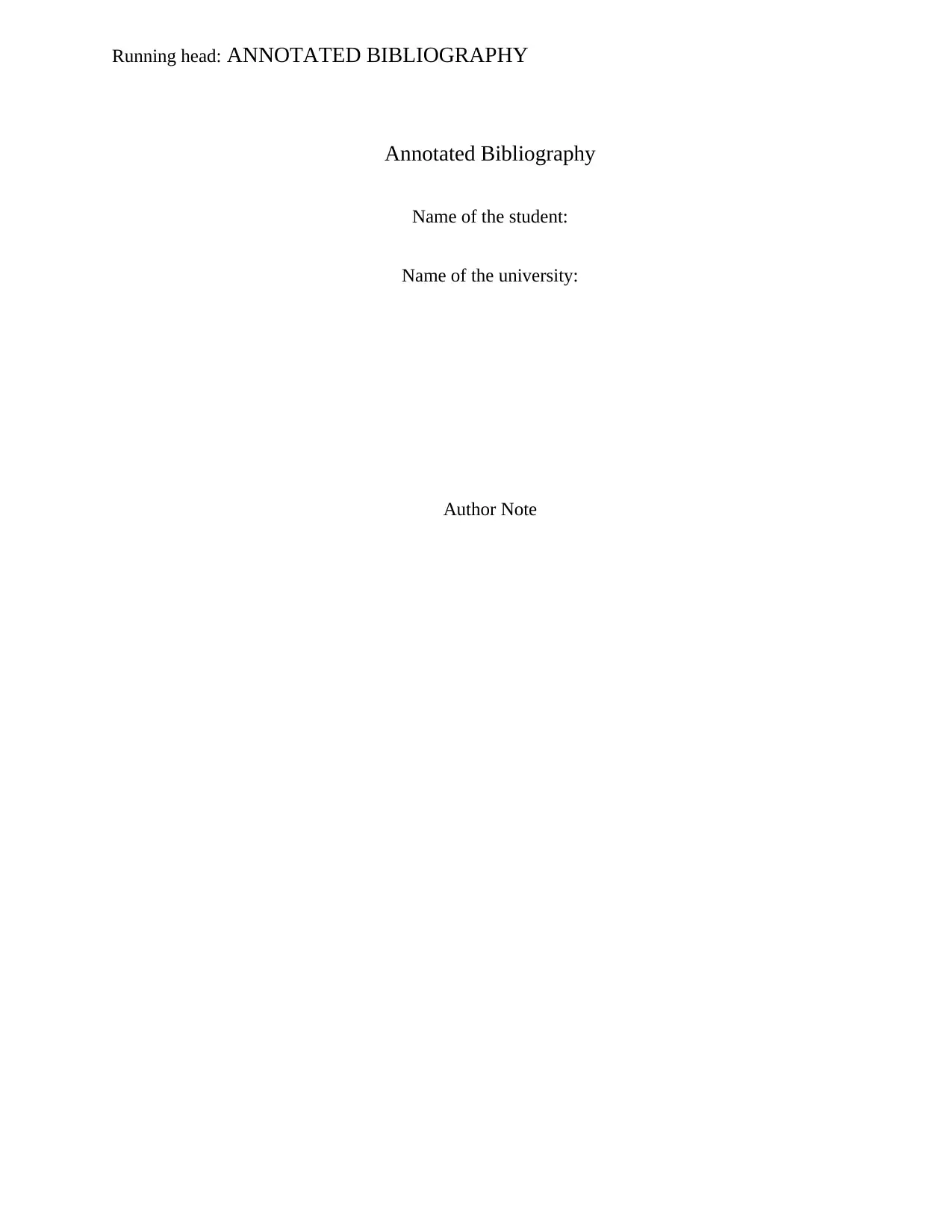
Running head: ANNOTATED BIBLIOGRAPHY
Annotated Bibliography
Name of the student:
Name of the university:
Author Note
Annotated Bibliography
Name of the student:
Name of the university:
Author Note
Paraphrase This Document
Need a fresh take? Get an instant paraphrase of this document with our AI Paraphraser

1ANNOTATED BIBLIOGRAPHY
Topic: "What is the role of technology and innovation in promoting food
security?"
1. Bibliographic details:
Augustin, M. A., Riley, M., Stockmann, R., Bennett, L., Kahl, A., Lockett, T., ... & Cobiac, L.
(2016). Role of food processing in food and nutrition security. Trends in Food Science &
Technology, 56, 115-125.
Introduction:
Title: Trends in Food Science & Technology
Year: 2016
Author Names: Augustin, M. A., Riley, M., Stockmann, R., Bennett, L., Kahl, A., Lockett, T., ... &
Cobiac, L.
Evaluation of the work:
The article analyzes food processing as a significant role to gain nutrition and food security.
The authors also help in decreasing food losses as a vital tool. This is to maximize the utility of
resource usage. A balanced approach is highlighted for nutrient and energy contents of foods are
needed. Then there are concerns about consumers regarding the processing of foods. This is to be
denoted regarding benefit acceptance. The article also highlights an effective and holistic approach.
This is done towards the present food supply chain of sustainable and efficiently, which is
investigated here.
Topic: "What is the role of technology and innovation in promoting food
security?"
1. Bibliographic details:
Augustin, M. A., Riley, M., Stockmann, R., Bennett, L., Kahl, A., Lockett, T., ... & Cobiac, L.
(2016). Role of food processing in food and nutrition security. Trends in Food Science &
Technology, 56, 115-125.
Introduction:
Title: Trends in Food Science & Technology
Year: 2016
Author Names: Augustin, M. A., Riley, M., Stockmann, R., Bennett, L., Kahl, A., Lockett, T., ... &
Cobiac, L.
Evaluation of the work:
The article analyzes food processing as a significant role to gain nutrition and food security.
The authors also help in decreasing food losses as a vital tool. This is to maximize the utility of
resource usage. A balanced approach is highlighted for nutrient and energy contents of foods are
needed. Then there are concerns about consumers regarding the processing of foods. This is to be
denoted regarding benefit acceptance. The article also highlights an effective and holistic approach.
This is done towards the present food supply chain of sustainable and efficiently, which is
investigated here.
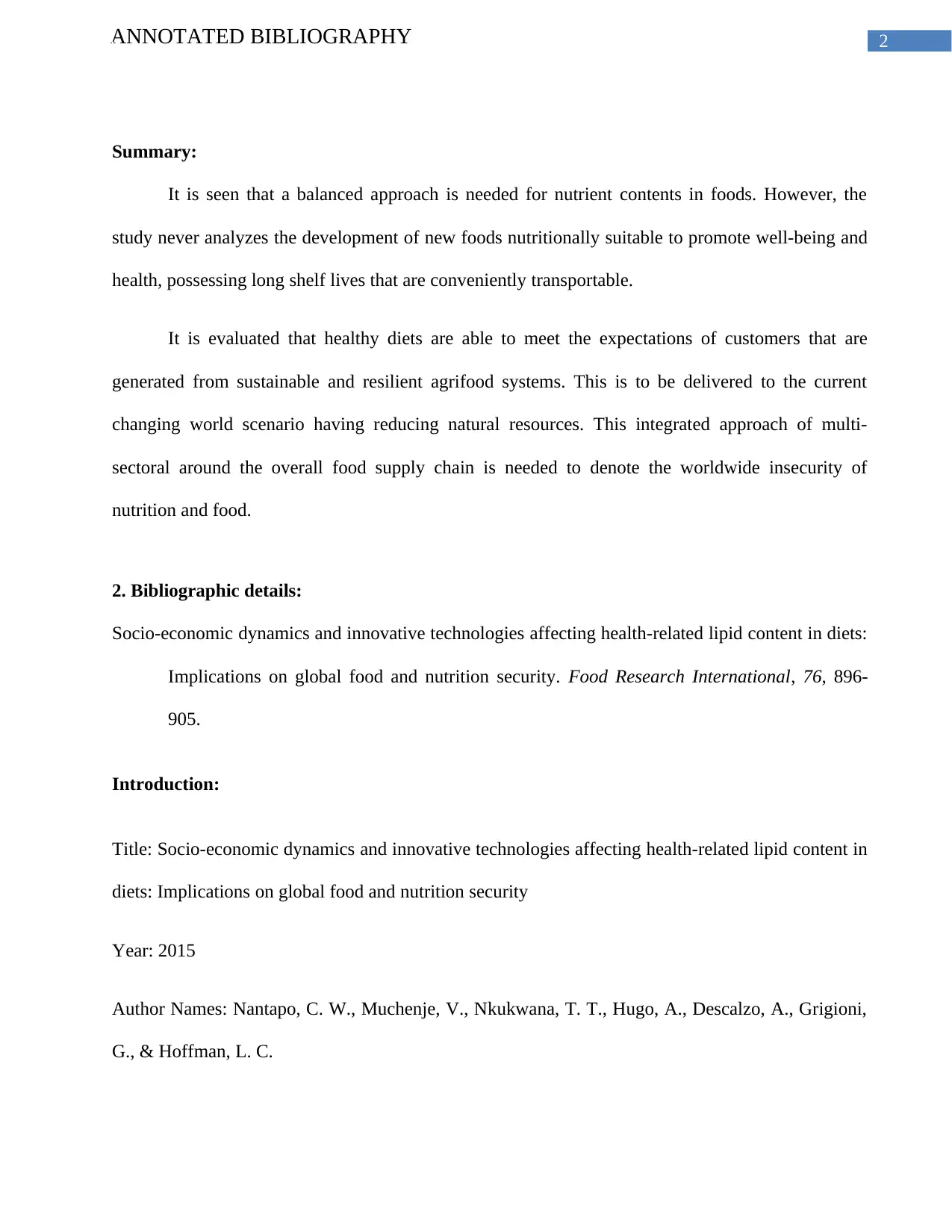
2ANNOTATED BIBLIOGRAPHY
Summary:
It is seen that a balanced approach is needed for nutrient contents in foods. However, the
study never analyzes the development of new foods nutritionally suitable to promote well-being and
health, possessing long shelf lives that are conveniently transportable.
It is evaluated that healthy diets are able to meet the expectations of customers that are
generated from sustainable and resilient agrifood systems. This is to be delivered to the current
changing world scenario having reducing natural resources. This integrated approach of multi-
sectoral around the overall food supply chain is needed to denote the worldwide insecurity of
nutrition and food.
2. Bibliographic details:
Socio-economic dynamics and innovative technologies affecting health-related lipid content in diets:
Implications on global food and nutrition security. Food Research International, 76, 896-
905.
Introduction:
Title: Socio-economic dynamics and innovative technologies affecting health-related lipid content in
diets: Implications on global food and nutrition security
Year: 2015
Author Names: Nantapo, C. W., Muchenje, V., Nkukwana, T. T., Hugo, A., Descalzo, A., Grigioni,
G., & Hoffman, L. C.
Summary:
It is seen that a balanced approach is needed for nutrient contents in foods. However, the
study never analyzes the development of new foods nutritionally suitable to promote well-being and
health, possessing long shelf lives that are conveniently transportable.
It is evaluated that healthy diets are able to meet the expectations of customers that are
generated from sustainable and resilient agrifood systems. This is to be delivered to the current
changing world scenario having reducing natural resources. This integrated approach of multi-
sectoral around the overall food supply chain is needed to denote the worldwide insecurity of
nutrition and food.
2. Bibliographic details:
Socio-economic dynamics and innovative technologies affecting health-related lipid content in diets:
Implications on global food and nutrition security. Food Research International, 76, 896-
905.
Introduction:
Title: Socio-economic dynamics and innovative technologies affecting health-related lipid content in
diets: Implications on global food and nutrition security
Year: 2015
Author Names: Nantapo, C. W., Muchenje, V., Nkukwana, T. T., Hugo, A., Descalzo, A., Grigioni,
G., & Hoffman, L. C.
⊘ This is a preview!⊘
Do you want full access?
Subscribe today to unlock all pages.

Trusted by 1+ million students worldwide
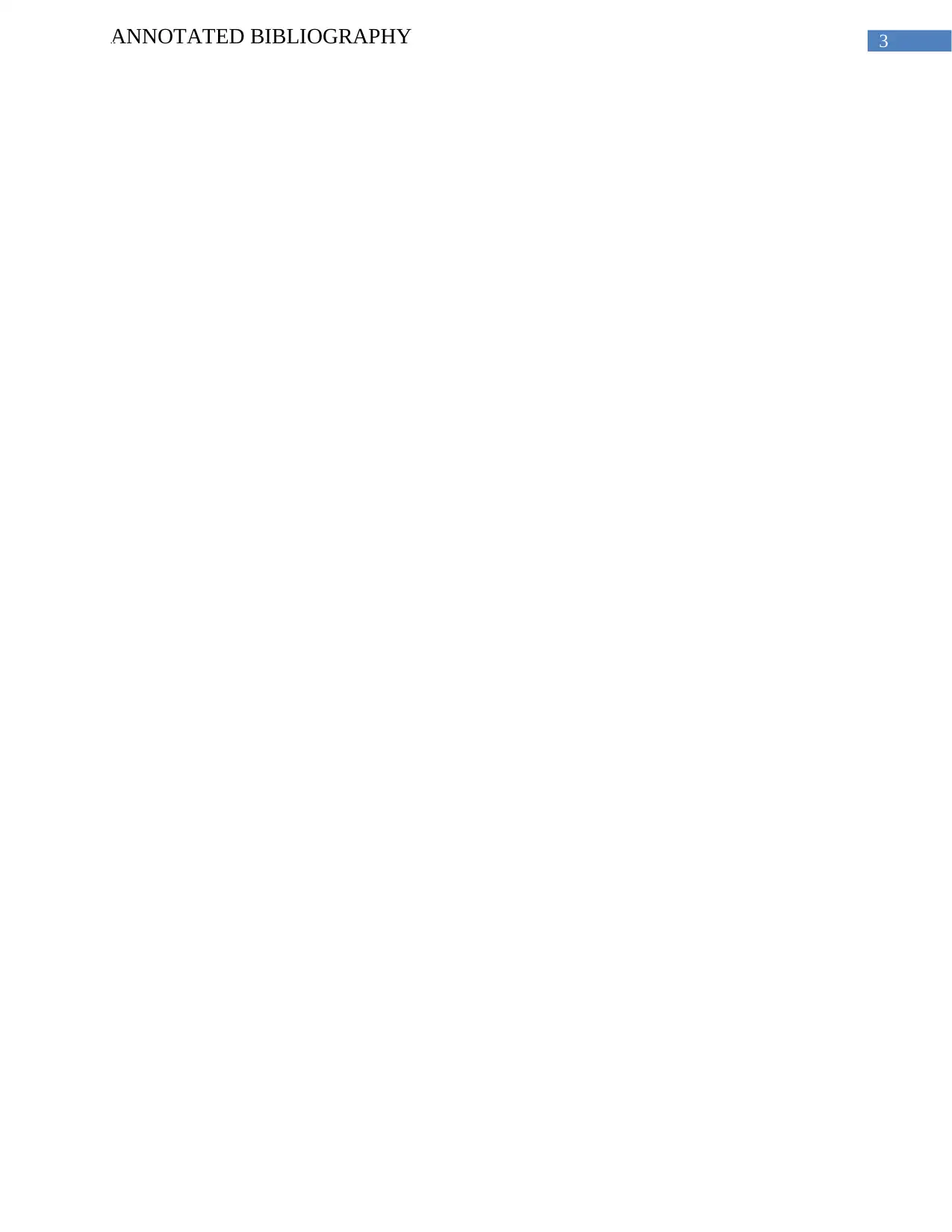
3ANNOTATED BIBLIOGRAPHY
Paraphrase This Document
Need a fresh take? Get an instant paraphrase of this document with our AI Paraphraser
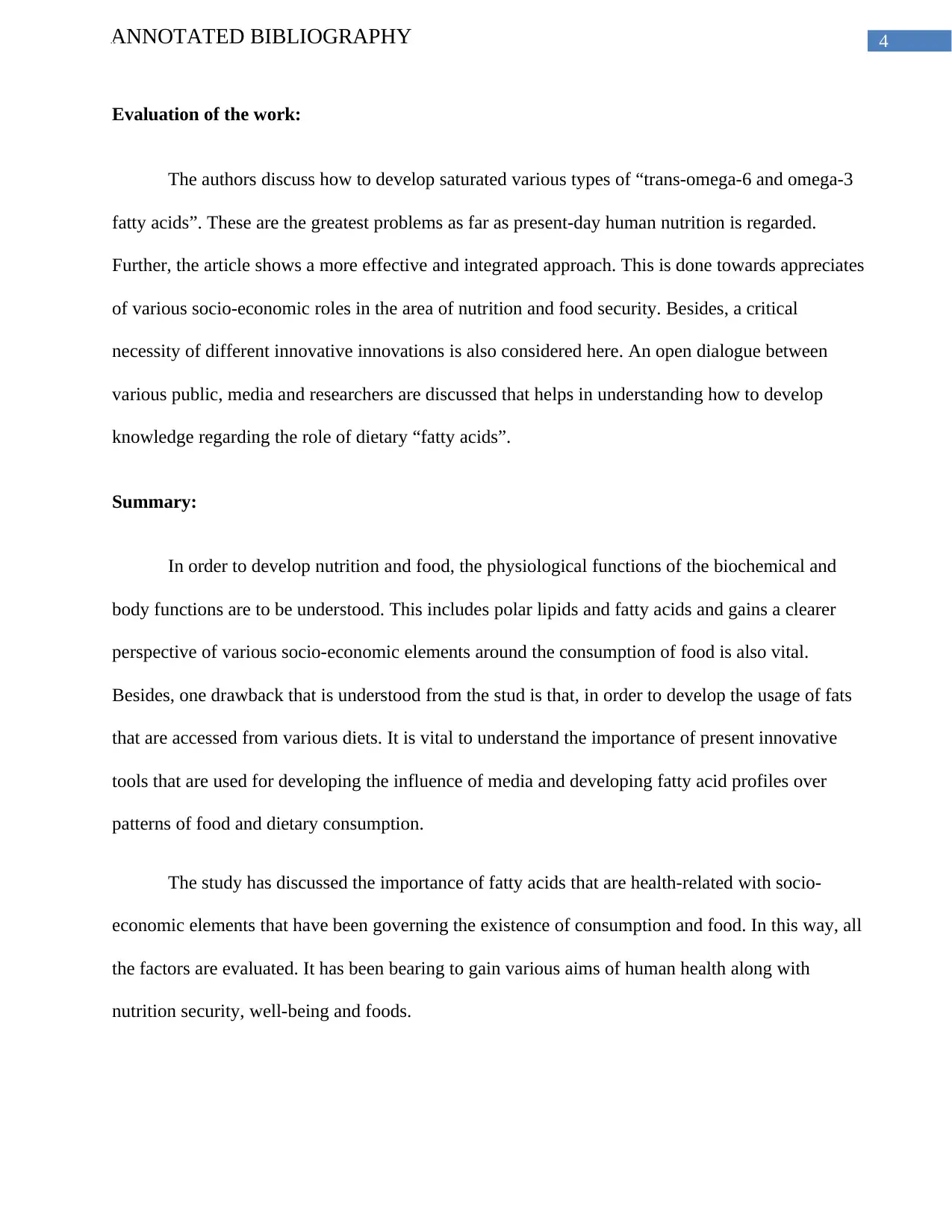
4ANNOTATED BIBLIOGRAPHY
Evaluation of the work:
The authors discuss how to develop saturated various types of “trans-omega-6 and omega-3
fatty acids”. These are the greatest problems as far as present-day human nutrition is regarded.
Further, the article shows a more effective and integrated approach. This is done towards appreciates
of various socio-economic roles in the area of nutrition and food security. Besides, a critical
necessity of different innovative innovations is also considered here. An open dialogue between
various public, media and researchers are discussed that helps in understanding how to develop
knowledge regarding the role of dietary “fatty acids”.
Summary:
In order to develop nutrition and food, the physiological functions of the biochemical and
body functions are to be understood. This includes polar lipids and fatty acids and gains a clearer
perspective of various socio-economic elements around the consumption of food is also vital.
Besides, one drawback that is understood from the stud is that, in order to develop the usage of fats
that are accessed from various diets. It is vital to understand the importance of present innovative
tools that are used for developing the influence of media and developing fatty acid profiles over
patterns of food and dietary consumption.
The study has discussed the importance of fatty acids that are health-related with socio-
economic elements that have been governing the existence of consumption and food. In this way, all
the factors are evaluated. It has been bearing to gain various aims of human health along with
nutrition security, well-being and foods.
Evaluation of the work:
The authors discuss how to develop saturated various types of “trans-omega-6 and omega-3
fatty acids”. These are the greatest problems as far as present-day human nutrition is regarded.
Further, the article shows a more effective and integrated approach. This is done towards appreciates
of various socio-economic roles in the area of nutrition and food security. Besides, a critical
necessity of different innovative innovations is also considered here. An open dialogue between
various public, media and researchers are discussed that helps in understanding how to develop
knowledge regarding the role of dietary “fatty acids”.
Summary:
In order to develop nutrition and food, the physiological functions of the biochemical and
body functions are to be understood. This includes polar lipids and fatty acids and gains a clearer
perspective of various socio-economic elements around the consumption of food is also vital.
Besides, one drawback that is understood from the stud is that, in order to develop the usage of fats
that are accessed from various diets. It is vital to understand the importance of present innovative
tools that are used for developing the influence of media and developing fatty acid profiles over
patterns of food and dietary consumption.
The study has discussed the importance of fatty acids that are health-related with socio-
economic elements that have been governing the existence of consumption and food. In this way, all
the factors are evaluated. It has been bearing to gain various aims of human health along with
nutrition security, well-being and foods.

5ANNOTATED BIBLIOGRAPHY
3. Bibliographic details:
Scarlat, N., Dallemand, J. F., Monforti-Ferrario, F., & Nita, V. (2015). The role of biomass and
bioenergy in a future bioeconomy: policies and facts. Environmental Development, 15, 3-34.
Introduction:
Title: The role of biomass and bioenergy in a future bioeconomy: Policies and facts
Authors: Scarlat, N., Dallemand, J. F., Monforti-Ferrario, F., & Nita, V.
Year: 2015.
Evaluation of the work:
The study shows how EU is set with long-term achievements for developing different low
carbon economy within 2050. The authors mention that bio-economy has been playing a crucial role
as far as low carbon economy is considered. EU consists of various well-established conventional
industries that are bio-based. Furthermore, the authors have estimated EU current economy of bio-
market that is seen to be about 2.4 billion dollars. Besides, it is also seen that bio-economy has been
depending on biomass availability, costs and advancements.
Summary:
In this paper analysis of present status is bio-economy in analyzed across the European
Union and around the glove till 2020. The present bio-economy market is estimated that is about 2.4
billion pounds and includes agro-industrial, food and beverage and agriculture with aquaculture and
3. Bibliographic details:
Scarlat, N., Dallemand, J. F., Monforti-Ferrario, F., & Nita, V. (2015). The role of biomass and
bioenergy in a future bioeconomy: policies and facts. Environmental Development, 15, 3-34.
Introduction:
Title: The role of biomass and bioenergy in a future bioeconomy: Policies and facts
Authors: Scarlat, N., Dallemand, J. F., Monforti-Ferrario, F., & Nita, V.
Year: 2015.
Evaluation of the work:
The study shows how EU is set with long-term achievements for developing different low
carbon economy within 2050. The authors mention that bio-economy has been playing a crucial role
as far as low carbon economy is considered. EU consists of various well-established conventional
industries that are bio-based. Furthermore, the authors have estimated EU current economy of bio-
market that is seen to be about 2.4 billion dollars. Besides, it is also seen that bio-economy has been
depending on biomass availability, costs and advancements.
Summary:
In this paper analysis of present status is bio-economy in analyzed across the European
Union and around the glove till 2020. The present bio-economy market is estimated that is about 2.4
billion pounds and includes agro-industrial, food and beverage and agriculture with aquaculture and
⊘ This is a preview!⊘
Do you want full access?
Subscribe today to unlock all pages.

Trusted by 1+ million students worldwide
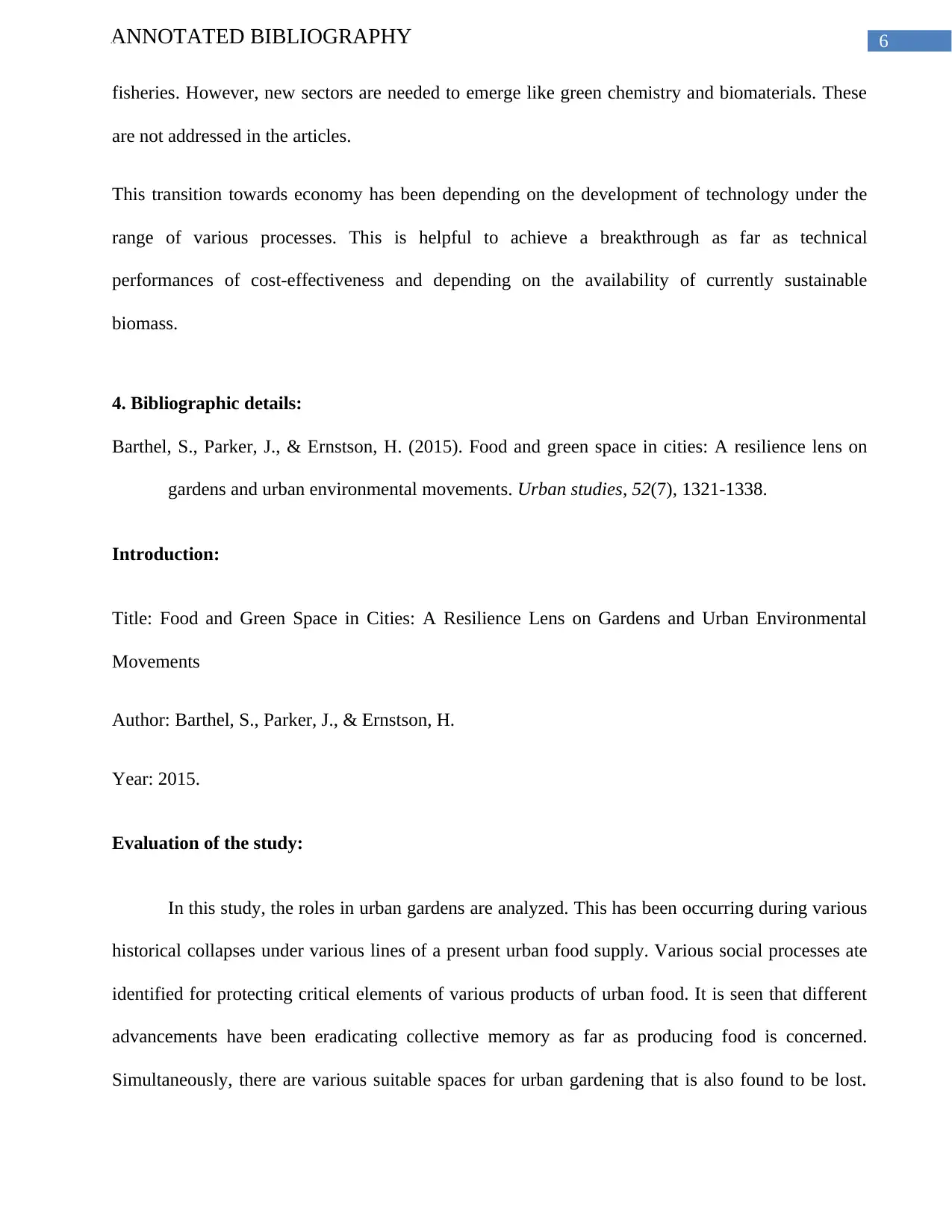
6ANNOTATED BIBLIOGRAPHY
fisheries. However, new sectors are needed to emerge like green chemistry and biomaterials. These
are not addressed in the articles.
This transition towards economy has been depending on the development of technology under the
range of various processes. This is helpful to achieve a breakthrough as far as technical
performances of cost-effectiveness and depending on the availability of currently sustainable
biomass.
4. Bibliographic details:
Barthel, S., Parker, J., & Ernstson, H. (2015). Food and green space in cities: A resilience lens on
gardens and urban environmental movements. Urban studies, 52(7), 1321-1338.
Introduction:
Title: Food and Green Space in Cities: A Resilience Lens on Gardens and Urban Environmental
Movements
Author: Barthel, S., Parker, J., & Ernstson, H.
Year: 2015.
Evaluation of the study:
In this study, the roles in urban gardens are analyzed. This has been occurring during various
historical collapses under various lines of a present urban food supply. Various social processes ate
identified for protecting critical elements of various products of urban food. It is seen that different
advancements have been eradicating collective memory as far as producing food is concerned.
Simultaneously, there are various suitable spaces for urban gardening that is also found to be lost.
fisheries. However, new sectors are needed to emerge like green chemistry and biomaterials. These
are not addressed in the articles.
This transition towards economy has been depending on the development of technology under the
range of various processes. This is helpful to achieve a breakthrough as far as technical
performances of cost-effectiveness and depending on the availability of currently sustainable
biomass.
4. Bibliographic details:
Barthel, S., Parker, J., & Ernstson, H. (2015). Food and green space in cities: A resilience lens on
gardens and urban environmental movements. Urban studies, 52(7), 1321-1338.
Introduction:
Title: Food and Green Space in Cities: A Resilience Lens on Gardens and Urban Environmental
Movements
Author: Barthel, S., Parker, J., & Ernstson, H.
Year: 2015.
Evaluation of the study:
In this study, the roles in urban gardens are analyzed. This has been occurring during various
historical collapses under various lines of a present urban food supply. Various social processes ate
identified for protecting critical elements of various products of urban food. It is seen that different
advancements have been eradicating collective memory as far as producing food is concerned.
Simultaneously, there are various suitable spaces for urban gardening that is also found to be lost.
Paraphrase This Document
Need a fresh take? Get an instant paraphrase of this document with our AI Paraphraser
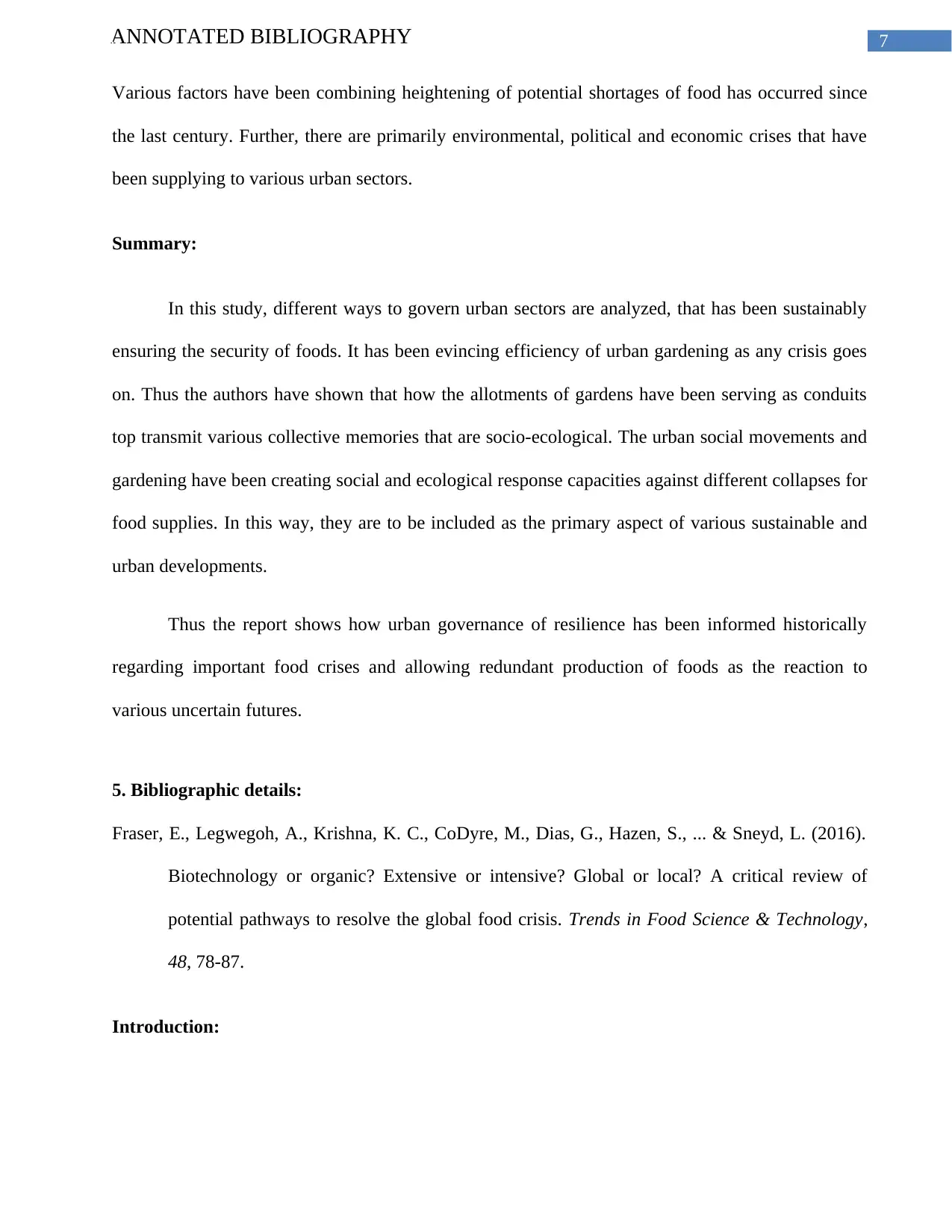
7ANNOTATED BIBLIOGRAPHY
Various factors have been combining heightening of potential shortages of food has occurred since
the last century. Further, there are primarily environmental, political and economic crises that have
been supplying to various urban sectors.
Summary:
In this study, different ways to govern urban sectors are analyzed, that has been sustainably
ensuring the security of foods. It has been evincing efficiency of urban gardening as any crisis goes
on. Thus the authors have shown that how the allotments of gardens have been serving as conduits
top transmit various collective memories that are socio-ecological. The urban social movements and
gardening have been creating social and ecological response capacities against different collapses for
food supplies. In this way, they are to be included as the primary aspect of various sustainable and
urban developments.
Thus the report shows how urban governance of resilience has been informed historically
regarding important food crises and allowing redundant production of foods as the reaction to
various uncertain futures.
5. Bibliographic details:
Fraser, E., Legwegoh, A., Krishna, K. C., CoDyre, M., Dias, G., Hazen, S., ... & Sneyd, L. (2016).
Biotechnology or organic? Extensive or intensive? Global or local? A critical review of
potential pathways to resolve the global food crisis. Trends in Food Science & Technology,
48, 78-87.
Introduction:
Various factors have been combining heightening of potential shortages of food has occurred since
the last century. Further, there are primarily environmental, political and economic crises that have
been supplying to various urban sectors.
Summary:
In this study, different ways to govern urban sectors are analyzed, that has been sustainably
ensuring the security of foods. It has been evincing efficiency of urban gardening as any crisis goes
on. Thus the authors have shown that how the allotments of gardens have been serving as conduits
top transmit various collective memories that are socio-ecological. The urban social movements and
gardening have been creating social and ecological response capacities against different collapses for
food supplies. In this way, they are to be included as the primary aspect of various sustainable and
urban developments.
Thus the report shows how urban governance of resilience has been informed historically
regarding important food crises and allowing redundant production of foods as the reaction to
various uncertain futures.
5. Bibliographic details:
Fraser, E., Legwegoh, A., Krishna, K. C., CoDyre, M., Dias, G., Hazen, S., ... & Sneyd, L. (2016).
Biotechnology or organic? Extensive or intensive? Global or local? A critical review of
potential pathways to resolve the global food crisis. Trends in Food Science & Technology,
48, 78-87.
Introduction:

8ANNOTATED BIBLIOGRAPHY
Title: Biotechnology or organic? Extensive or intensive? Global or local? A critical review of
potential pathways to resolve the global food crisis
Author name: Fraser, E., Legwegoh, A., Krishna, K. C., CoDyre, M., Dias, G., Hazen, S., ... &
Sneyd, L.
Year: 2016
Summary:
Till date, some attention is paid to how the stakeholders have perceived URF and UA in the
Mediterranean and the role of food prediction in those initiatives. Here, the inclusion and promotion
of latest forms of UA with practices of URF and contribute are done as a preliminary study over
public perceptions and stakeholders of UA.
Besides, various stakeholders have mentioned the potential to rise urban fertility with the
help of URF and occupy the present unused areas. In this way, a positive valuation of URF has been
depending on a conceptualization of UA as the food production activity. On the other hand, these
conceptualizations have been shaping the opportunities and barriers for developing URF.
6. Bibliographic details:
Sonnino, R. (2016). The new geography of food security: exploring the potential of urban food
strategies. The Geographical Journal, 182(2), 190-200.
Introduction:
Title: The new geography of food security: exploring the potential of urban food strategies.
Author: Sonnino, R.
Title: Biotechnology or organic? Extensive or intensive? Global or local? A critical review of
potential pathways to resolve the global food crisis
Author name: Fraser, E., Legwegoh, A., Krishna, K. C., CoDyre, M., Dias, G., Hazen, S., ... &
Sneyd, L.
Year: 2016
Summary:
Till date, some attention is paid to how the stakeholders have perceived URF and UA in the
Mediterranean and the role of food prediction in those initiatives. Here, the inclusion and promotion
of latest forms of UA with practices of URF and contribute are done as a preliminary study over
public perceptions and stakeholders of UA.
Besides, various stakeholders have mentioned the potential to rise urban fertility with the
help of URF and occupy the present unused areas. In this way, a positive valuation of URF has been
depending on a conceptualization of UA as the food production activity. On the other hand, these
conceptualizations have been shaping the opportunities and barriers for developing URF.
6. Bibliographic details:
Sonnino, R. (2016). The new geography of food security: exploring the potential of urban food
strategies. The Geographical Journal, 182(2), 190-200.
Introduction:
Title: The new geography of food security: exploring the potential of urban food strategies.
Author: Sonnino, R.
⊘ This is a preview!⊘
Do you want full access?
Subscribe today to unlock all pages.

Trusted by 1+ million students worldwide
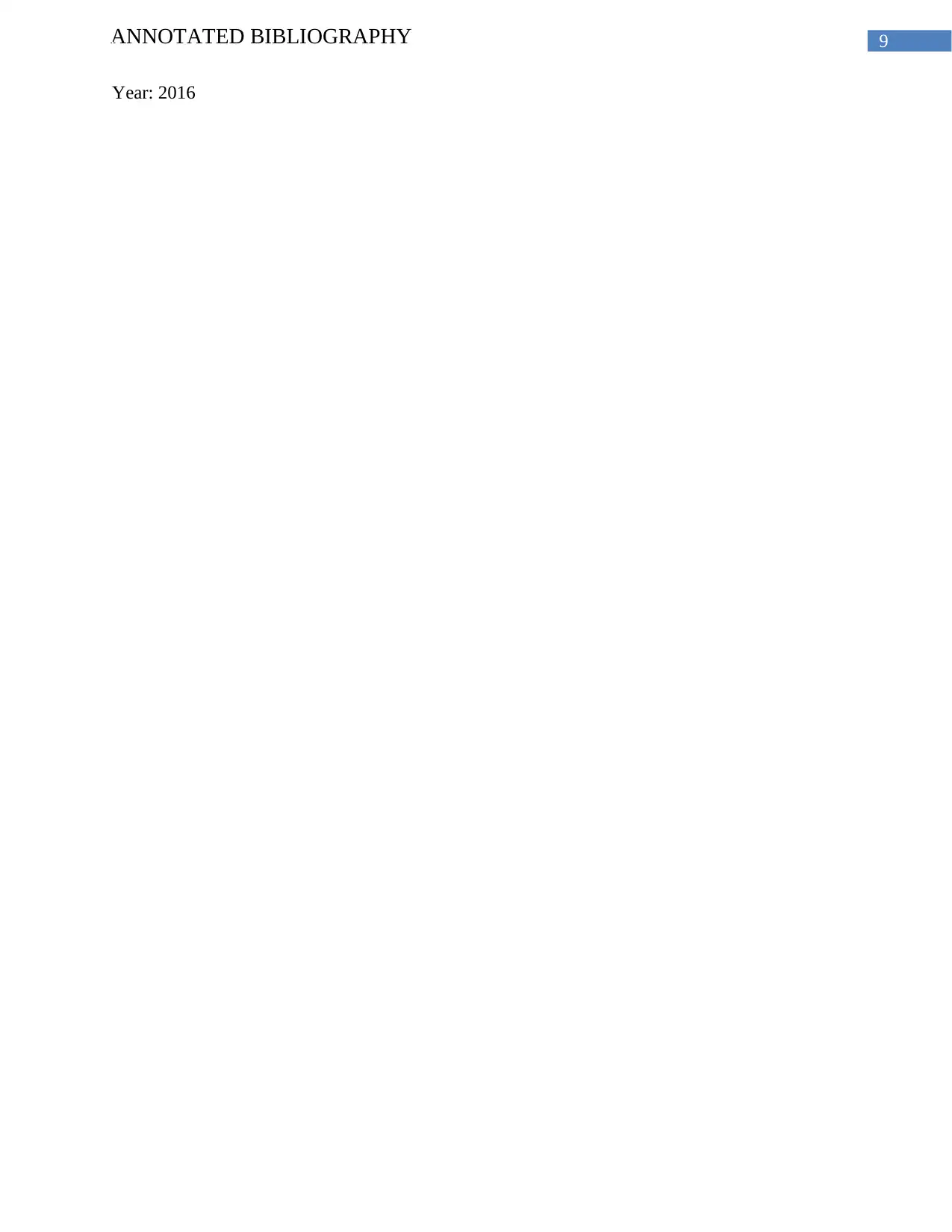
9ANNOTATED BIBLIOGRAPHY
Year: 2016
Year: 2016
Paraphrase This Document
Need a fresh take? Get an instant paraphrase of this document with our AI Paraphraser
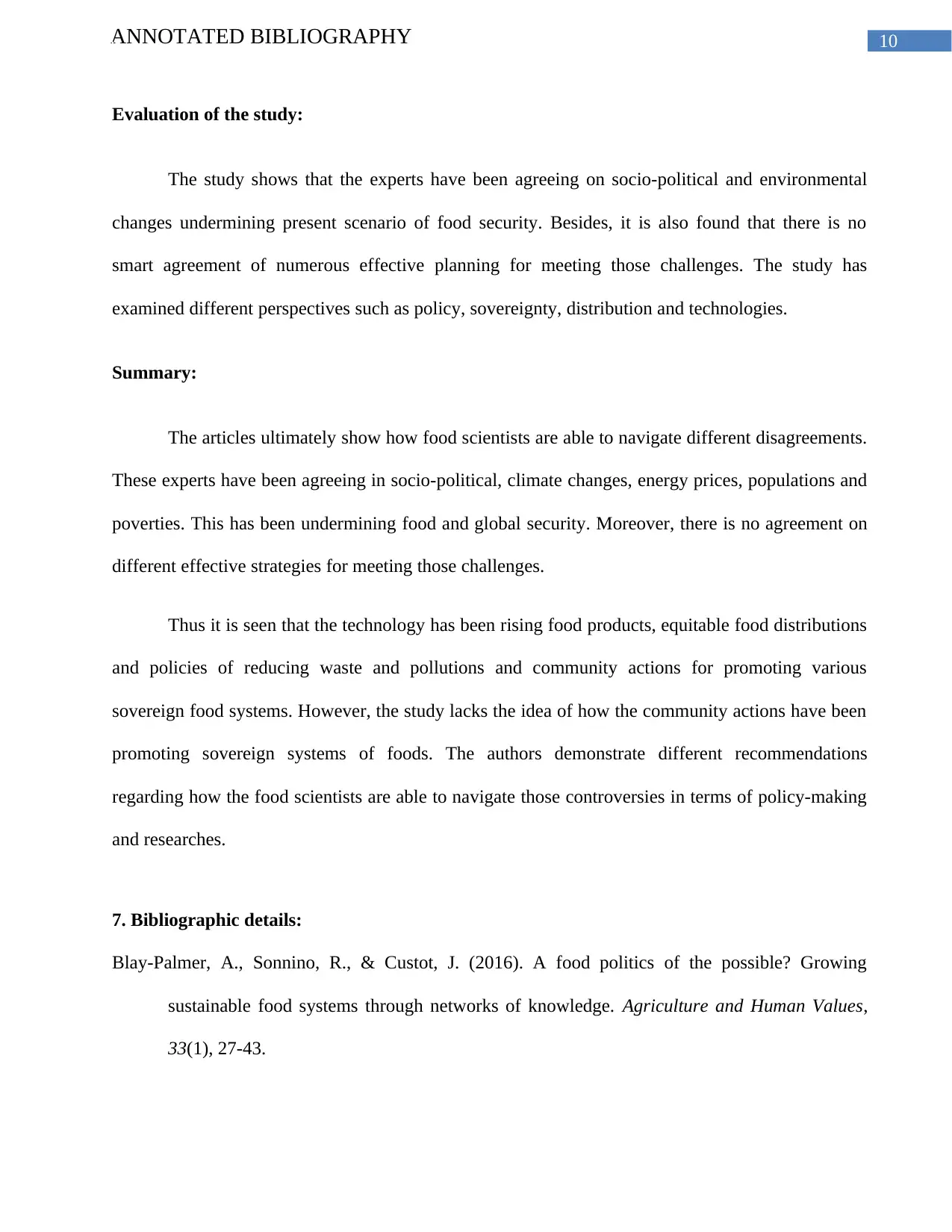
10ANNOTATED BIBLIOGRAPHY
Evaluation of the study:
The study shows that the experts have been agreeing on socio-political and environmental
changes undermining present scenario of food security. Besides, it is also found that there is no
smart agreement of numerous effective planning for meeting those challenges. The study has
examined different perspectives such as policy, sovereignty, distribution and technologies.
Summary:
The articles ultimately show how food scientists are able to navigate different disagreements.
These experts have been agreeing in socio-political, climate changes, energy prices, populations and
poverties. This has been undermining food and global security. Moreover, there is no agreement on
different effective strategies for meeting those challenges.
Thus it is seen that the technology has been rising food products, equitable food distributions
and policies of reducing waste and pollutions and community actions for promoting various
sovereign food systems. However, the study lacks the idea of how the community actions have been
promoting sovereign systems of foods. The authors demonstrate different recommendations
regarding how the food scientists are able to navigate those controversies in terms of policy-making
and researches.
7. Bibliographic details:
Blay-Palmer, A., Sonnino, R., & Custot, J. (2016). A food politics of the possible? Growing
sustainable food systems through networks of knowledge. Agriculture and Human Values,
33(1), 27-43.
Evaluation of the study:
The study shows that the experts have been agreeing on socio-political and environmental
changes undermining present scenario of food security. Besides, it is also found that there is no
smart agreement of numerous effective planning for meeting those challenges. The study has
examined different perspectives such as policy, sovereignty, distribution and technologies.
Summary:
The articles ultimately show how food scientists are able to navigate different disagreements.
These experts have been agreeing in socio-political, climate changes, energy prices, populations and
poverties. This has been undermining food and global security. Moreover, there is no agreement on
different effective strategies for meeting those challenges.
Thus it is seen that the technology has been rising food products, equitable food distributions
and policies of reducing waste and pollutions and community actions for promoting various
sovereign food systems. However, the study lacks the idea of how the community actions have been
promoting sovereign systems of foods. The authors demonstrate different recommendations
regarding how the food scientists are able to navigate those controversies in terms of policy-making
and researches.
7. Bibliographic details:
Blay-Palmer, A., Sonnino, R., & Custot, J. (2016). A food politics of the possible? Growing
sustainable food systems through networks of knowledge. Agriculture and Human Values,
33(1), 27-43.
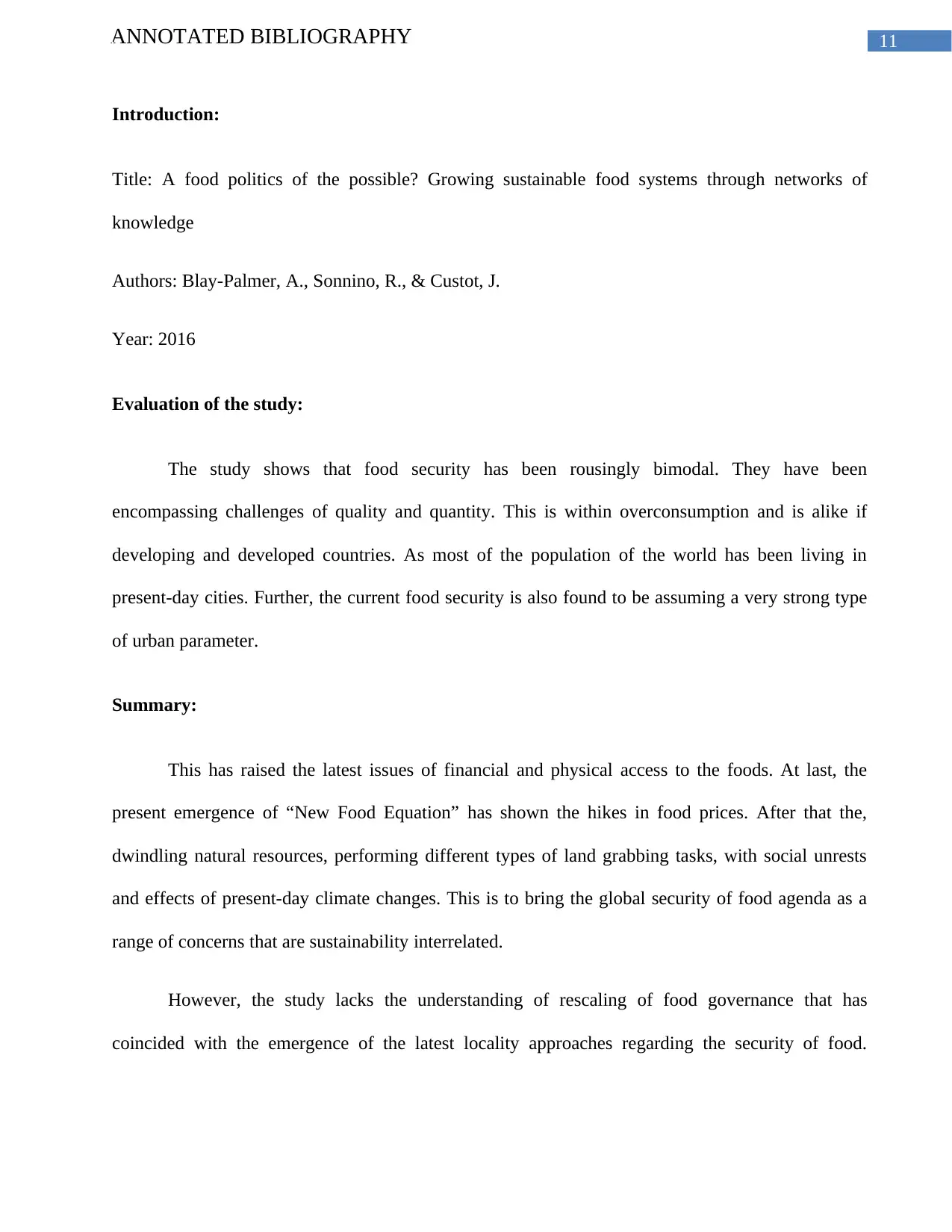
11ANNOTATED BIBLIOGRAPHY
Introduction:
Title: A food politics of the possible? Growing sustainable food systems through networks of
knowledge
Authors: Blay-Palmer, A., Sonnino, R., & Custot, J.
Year: 2016
Evaluation of the study:
The study shows that food security has been rousingly bimodal. They have been
encompassing challenges of quality and quantity. This is within overconsumption and is alike if
developing and developed countries. As most of the population of the world has been living in
present-day cities. Further, the current food security is also found to be assuming a very strong type
of urban parameter.
Summary:
This has raised the latest issues of financial and physical access to the foods. At last, the
present emergence of “New Food Equation” has shown the hikes in food prices. After that the,
dwindling natural resources, performing different types of land grabbing tasks, with social unrests
and effects of present-day climate changes. This is to bring the global security of food agenda as a
range of concerns that are sustainability interrelated.
However, the study lacks the understanding of rescaling of food governance that has
coincided with the emergence of the latest locality approaches regarding the security of food.
Introduction:
Title: A food politics of the possible? Growing sustainable food systems through networks of
knowledge
Authors: Blay-Palmer, A., Sonnino, R., & Custot, J.
Year: 2016
Evaluation of the study:
The study shows that food security has been rousingly bimodal. They have been
encompassing challenges of quality and quantity. This is within overconsumption and is alike if
developing and developed countries. As most of the population of the world has been living in
present-day cities. Further, the current food security is also found to be assuming a very strong type
of urban parameter.
Summary:
This has raised the latest issues of financial and physical access to the foods. At last, the
present emergence of “New Food Equation” has shown the hikes in food prices. After that the,
dwindling natural resources, performing different types of land grabbing tasks, with social unrests
and effects of present-day climate changes. This is to bring the global security of food agenda as a
range of concerns that are sustainability interrelated.
However, the study lacks the understanding of rescaling of food governance that has
coincided with the emergence of the latest locality approaches regarding the security of food.
⊘ This is a preview!⊘
Do you want full access?
Subscribe today to unlock all pages.

Trusted by 1+ million students worldwide
1 out of 14
Your All-in-One AI-Powered Toolkit for Academic Success.
+13062052269
info@desklib.com
Available 24*7 on WhatsApp / Email
![[object Object]](/_next/static/media/star-bottom.7253800d.svg)
Unlock your academic potential
Copyright © 2020–2025 A2Z Services. All Rights Reserved. Developed and managed by ZUCOL.